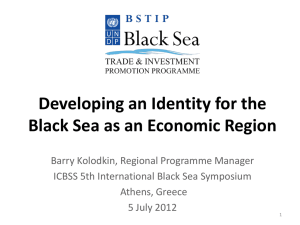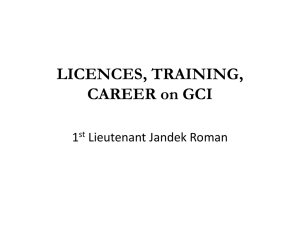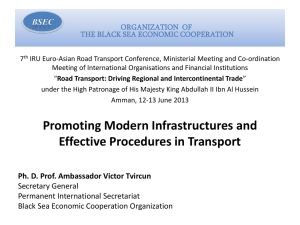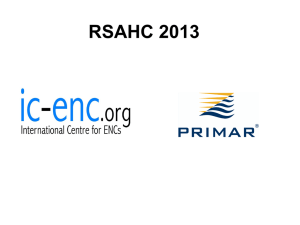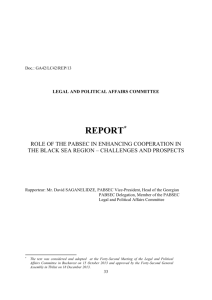Mr. Nikolaos Hlepas
advertisement
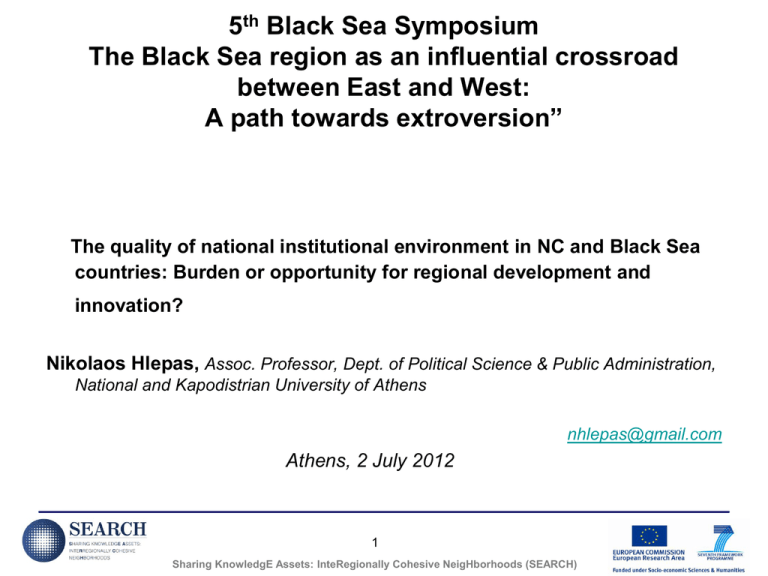
5th Black Sea Symposium The Black Sea region as an influential crossroad between East and West: A path towards extroversion” The quality of national institutional environment in NC and Black Sea countries: Burden or opportunity for regional development and innovation? Nikolaos Hlepas, Assoc. Professor, Dept. of Political Science & Public Administration, National and Kapodistrian University of Athens nhlepas@gmail.com Athens, 2 July 2012 1 Sharing KnowledgE Assets: InteRegionally Cohesive NeigHborhoods (SEARCH) Comparative View of the Quality of National Institutional Environments Background The Research (based on SEARCH program WP5.3) focuses on features of institutions at the national level (due to the lack of data at the regional level). The quality of institutions relies mainly on qualitative assessment and is not easy to measure (Kaufmann et al. 2008). World Economic Forum provides a solid base of common indicators and empirical data based on a sample of qualified professionals of the business sector reflecting their perceptions as actors in different institutional environment. The aforementioned indicators are particularly useful because they are common for all countries in a period from 2004-2011, covering key features of institutional performance. Main aspects of institutional performance that will be examined are: a. Government Effectiveness , b. Regulatory Quality, c. Rule of Law d. Control of Corruption (Jurlin K./ Cuckovic, N.: 2009) The aim of this research exercise is to highlight trends of institutional performance across time for selected countries which are grouped in clusters according to the pace of Europeanization: EU countries (e.g. Greece, Romania, Bulgaria), candidate countries (e.g. Turkey, Croatia) .Furthermore, trends will be examined according to different geographical cooperation countries (e.g. Black Sea countries, Southern Mediterranean NC, Eastern NC). Furthermore, convergencies or divergencies among countries of the same group will be examined in the period (2004-2011) using the coefficient of variation. 2 Sharing KnowledgE Assets: InteRegionally Cohesive NeigHborhoods (SEARCH) Comparative View of the Quality of National Institutional Environments Assumptions •Different national institutional frameworks influence the Europeanization process ( e.g. Heritier, Guallini, Bach, Paraskevopoulos/Getimis/ Riss et. al.) .Divergent processes of Europeanization in different countries and macro-regions reflect “Goodness of Fit” or “MissFit”, along line different responses of domestic legal and regulatory structures to the “European Community aquis”. •The main thesis is that “path-dependency” influences the changes and transformations of the legal and administrative structures, which are promoted by the European programmes and the co-operation agreements in Macro-Regions (e.g. Black Sea Conventions and multi-lateral agreements). Thus, different trajectories of change emerge, with different paces and velocities, while traditional structures and practices co-exist with innovative modernization efforts. In any case, most of the evaluation reports highlight that even in cases of legal compliance, implementation of policies is lagging behind. 3 Sharing KnowledgE Assets: InteRegionally Cohesive NeigHborhoods (SEARCH) Comparative View of the Quality of National Institutional Environments Hypotheses 1. EU member states (e.g. Gr., Bu., Ro.), through the Europeanization process, show better institutional performance than candidate countries (e.g. Turkey, Croatia). 2. Candidate countries move more close to a trajectory of “goodness of Fit” than other NC Black sea countries. 3. Every country has its “significant trajectory” of institutional performance. Other factors, than Europeanization, play also an important role. 4. Countries with a political and administrative culture closer to the “weberian” bureaucracy of middle Europe (e.g. Croatia) do better than countries with individual political culture, clientelism and personalized networks (e.g. Bulgaria, Greece). 5. In general, Europeanization Process and ENPI can promote improvement of national institutional environment and convergence of performance across countries. 6. Better performance of national institutional environments goes alongside with better scores in competitiveness of national economy. 4 Sharing KnowledgE Assets: InteRegionally Cohesive NeigHborhoods (SEARCH) Comparative View of the Quality of National Institutional Environments Main research questions •Which different trajectories concerning institutional performance emerge alongside single countries or clusters of countries (Europeanization, Regional Cooperation) •What kinds of differences by aspects of institutional performance between EU, EU Candidates, BSEC and ENP countries? Data sources •The main source is the World Economic Forum (The Global Competitiveness Report, Issues 2004-2011) Methodology •Analysis and evaluation of selected institutional indicators using aforementioned data source. 5 Sharing KnowledgE Assets: InteRegionally Cohesive NeigHborhoods (SEARCH) Comparative View of the Quality of National Institutional Environments Selected Indicators from WEF: 1. Government Effectiveness 1.1 Public trust of politicians 1.2 Favoritism in decisions of government officials 1.3 Wastefulness of government spending 1.4 Burden of government regulation 2. Regulatory Quality 2.1 Efficiency of legal framework 2.2. Transparency of government policy making 2.3. Strength of auditing and reporting standards 2.4. Efficacy of corporate boards 2.5. Protection of minority shareholders’ interests 6 Sharing KnowledgE Assets: InteRegionally Cohesive NeigHborhoods (SEARCH) Comparative View of the Quality of National Institutional Environments Selected Indicators from WEF: 3. Rule of Law 3.1 Property rights 3.2 Intellectual property protection 3.3 Judicial independence 3.4 Business costs of terrorism 3.5 Business costs of crime and violence 3.6 Organized crime 3.7 Reliability of police services 4. Control of Corruption 4.1 Diversion of public funds 4.2 Ethical behavior of firms 7 Sharing KnowledgE Assets: InteRegionally Cohesive NeigHborhoods (SEARCH) Comparative View of the Quality of National Institutional Environments Literature Background 1. 2. 3. 4. 5. 6. Jurlin, K./ Cuckovic, N. (2009). Comparative Analysis of the Quality of Institutions in the European Countries, Associzione Italiana per lo Studio dei Sistemi Economici Comparati, XIIth Scientific Conference, Growth and Development Patterns: The Role of Institutions in a Comparative Perspective, University of Perugia, Perugia. Kaufmann, D., Kraay, A., Mastruzzi, M. (2008). Governance matters: Aggregate and Individual Governance Indicators, 1996-2007. World Bank Policy Research Working Paper, No 4654, available at SSRN: http//ssrn.com/abstract=1148386. Heritier, Adr. (2005) , Europeanization Research East and West: A Comparative Assessment, in: Schimmelfennig, Fr. , Sedelmeier, Ulr. (ed.), The Europeanization of Central and Eastern Europe, Ithaca, NY, Cornell University Press, 199-209. Gualini, E. (guest ed.) (2006), European Planning Studies, Vol. 14, No. 7: ‘Governance Rescaling in Europe: Analytical and Empirical Explorations’ Bache, I., Marshall, Ad. (2004), Europeanisation and Domestic Change: A Governance Approach to Institutional Adaptation in Britain. IES Queen's University of Belfast: Queen's Papers on Europeanisation. Paraskevopoulos, Chr./ Getimis, P./ Rees, N. (2006): Adapting to EU Multi-Level Governance Regional and Environmental Policies in Cohesion and CEE Countries, Ashgate, Aldershot. 8 Sharing KnowledgE Assets: InteRegionally Cohesive NeigHborhoods (SEARCH) Index of Quality of Institutional Environment 5,5 EU 15 5,0 EU 27 4,5 Candidate countries 4,0 ENC total East ENC 3,5 South ENC 3,0 BSEC 2,5 2004 2006 2008 2010 2011 Government Effectiveness - Candidate coutnries 110,0 100,0 Croatia Macedonia, FYR 90,0 Montenegro 80,0 Serbia 70,0 Turkey EU 15 60,0 50,0 2004 2006 2008 2010 2011 Regulatory Quality - Candidate countries 110,0 100,0 Croatia Macedonia, FYR 90,0 Montenegro 80,0 Serbia 70,0 Turkey EU 15 60,0 50,0 2004 2006 2008 2010 2011 Rule of Law - Candidate countries 110,0 100,0 Croatia 90,0 Macedonia, FYR 80,0 Montenegro 70,0 Serbia Turkey 60,0 EU 15 50,0 40,0 2004 2006 2008 2010 2011 Control of Corruption - Candidate countries 110,0 100,0 Croatia 90,0 Macedonia, FYR 80,0 Montenegro 70,0 Serbia Turkey 60,0 EU 15 50,0 40,0 2004 2006 2008 2010 2011 Index of Quality of Institutional Environment Candidate countries 110,0 100,0 Croatia Macedonia, FYR 90,0 Montenegro 80,0 Serbia 70,0 Turkey EU 15 60,0 50,0 2004 2006 2008 2010 2011 Government Effectiveness - BSEC 110.0 Albania Armenia 100.0 Azerbaijan Bulgaria 90.0 Georgia Greece 80.0 Moldova Romania 70.0 Russian Federation Serbia 60.0 Turkey Ukraine 50.0 2004 2006 2008 2010 2011 EU 15 Regulatory Quality - BSEC 110.0 Albania Armenia 100.0 Azerbaijan Bulgaria 90.0 Georgia Greece 80.0 Moldova Romania 70.0 Russian Federation Serbia 60.0 Turkey Ukraine 50.0 2004 2006 2008 2010 2011 EU 15 Rule of Law - BSEC 110.0 Albania Armenia 100.0 Azerbaijan Bulgaria 90.0 Georgia Greece 80.0 Moldova Romania 70.0 Russian Federation Serbia 60.0 Turkey Ukraine 50.0 2004 2006 2008 2010 2011 EU 15 Control of Corruption - BSEC 110.0 Albania Armenia 100.0 Azerbaijan 90.0 Bulgaria Georgia 80.0 Greece Moldova 70.0 Romania Russian Federation 60.0 Serbia 50.0 Turkey Ukraine 40.0 EU 15 2004 2006 2008 2010 2011 Index of Quality of Institutional Framework - BSEC 110.0 Albania Armenia 100.0 Azerbaijan Bulgaria 90.0 Georgia Greece 80.0 Moldova Romania 70.0 Russian Federation Serbia 60.0 Turkey Ukraine 50.0 2004 2006 2008 2010 2011 EU 15 Government Effectiveness - ENC East 120.0 100.0 Armenia Azerbaijan 80.0 Belarus 60.0 Georgia Moldova 40.0 Ukraine EU 15 20.0 0.0 2004 2006 2008 2010 2011 Regulatory Quality - ENC East 105.0 100.0 95.0 Armenia 90.0 Azerbaijan Belarus 85.0 Georgia 80.0 Moldova 75.0 Ukraine 70.0 EU 15 65.0 60.0 2004 2006 2008 2010 2011 Rule of Law - ENC East 110.0 100.0 Armenia Azerbaijan 90.0 Belarus 80.0 Georgia Moldova 70.0 Ukraine EU 15 60.0 50.0 2004 2006 2008 2010 2011 Control of Corruption - ENC East 110.0 100.0 Armenia 90.0 Azerbaijan 80.0 Belarus Georgia 70.0 Moldova 60.0 Ukraine EU 15 50.0 40.0 2004 2006 2008 2010 2011 Index of Quality of Institutional Framework - ENC East 110.0 100.0 Armenia Azerbaijan 90.0 Belarus 80.0 Georgia Moldova 70.0 Ukraine EU 15 60.0 50.0 2004 2006 2008 2010 2011 Government Effectiveness - ENC South 140.0 130.0 Algeria Egypt 120.0 Israel 110.0 Jordan Lebanon 100.0 Libya 90.0 Morocco* Syria 80.0 Tunisia 70.0 EU 15 60.0 2004 2006 2008 2010 2011 Regulatory Law - ENC South 110.0 Algeria 105.0 Egypt 100.0 Israel 95.0 Jordan 90.0 Lebanon 85.0 Libya 80.0 Morocco* 75.0 Syria 70.0 Tunisia 65.0 EU 15 60.0 2004 2006 2008 2010 2011 Rule of Law - ENC South 110.0 Algeria Egypt 100.0 Israel 90.0 Jordan Lebanon 80.0 Libya Morocco* 70.0 Syria 60.0 Tunisia EU 15 50.0 2004 2006 2008 2010 2011 Conrol of Corruption - ENC South 110.0 Algeria 100.0 Egypt 90.0 Israel Jordan 80.0 Lebanon 70.0 Libya Morocco* 60.0 Syria Tunisia 50.0 EU 15 40.0 2004 2006 2008 2010 2011 Index of Quality of Institutional Framework ENC South 110.0 105.0 Algeria 100.0 Egypt 95.0 Israel Jordan 90.0 Lebanon 85.0 Libya 80.0 Morocco* 75.0 Syria 70.0 Tunisia 65.0 EU 15 60.0 2004 2006 2008 2010 2011 Government Effectiveness - ENC Total Armenia Algeria Azerbaijan 140.0 Belarus 130.0 Egypt 120.0 Georgia 110.0 Israel 100.0 Jordan 90.0 Lebanon 80.0 Libya 70.0 Moldova Morocco* 60.0 Syria 50.0 Tunisia 40.0 2004 2006 2008 2010 2011 Ukraine EU 15 Regulatory Quality - ENC Total Armenia Algeria Azerbaijan 110.0 Belarus 105.0 Egypt 100.0 Georgia 95.0 Israel 90.0 Jordan 85.0 Lebanon 80.0 Libya 75.0 Moldova Morocco* 70.0 Syria 65.0 Tunisia 60.0 2004 2006 2008 2010 2011 Ukraine EU 15 Armenia Rule of Law - ENC Total Algeria Azerbaijan 110.0 Belarus Egypt 100.0 Georgia 90.0 Israel Jordan 80.0 Lebanon 70.0 Libya Moldova 60.0 Morocco* 50.0 Syria Tunisia 40.0 2004 2006 2008 2010 2011 Ukraine EU 15 Control of Corruption - ENC Total Armenia Algeria Azerbaijan 110.0 Belarus Egypt 100.0 Georgia 90.0 Israel Jordan 80.0 Lebanon 70.0 Libya Moldova 60.0 Morocco* 50.0 Syria Tunisia 40.0 2004 2006 2008 2010 2011 Ukraine EU 15 Index of Quality of Institutional Framework ENC Total Armenia Algeria Azerbaijan Belarus 110.0 Egypt Georgia 100.0 Israel 90.0 Jordan Lebanon 80.0 Libya Moldova 70.0 Morocco* 60.0 Syria Tunisia 50.0 2004 2006 2008 2010 2011 Ukraine EU 15 Coefficient of variation of the index of Quality of Institutional Environment 25.0 EU 15 20.0 EU 27 Candidate countries 15.0 ENC total 10.0 East ENC South ENC 5.0 BSEC 0.0 2004 2006 2008 2010 2011 Relation of GCI with QIEI - BSEC 4,20 4,00 3,80 Global Competitiveness Index 3,60 Quality of Institutional Environment Index 3,40 3,20 3,00 2004 2006 2008 2010 2011 Relation of GCI with QIEI - ENC East 4,10 3,90 3,70 Global Competitiveness Index 3,50 3,30 Quality of Institutional Environment Index 3,10 2,90 2,70 2,50 2004 2006 2008 2010 2011 Relation of GCI with QIEI - Candidate countries 4,20 4,00 3,80 Global Competitiveness Index 3,60 Quality of Institutional Environment Index 3,40 3,20 3,00 2004 2006 2008 2010 2011 Relation of GCI with QIEI BSEC / ENC East / Candidate coutnries 4,20 4,00 BSEC GCI 3,80 BSEC QIEI 3,60 ENC East GCI 3,40 ENC East QIEI Candidate GCI 3,20 Candidate QIEI 3,00 2,80 2004 2006 2008 2010 2011 Relation of GCI with QIEI - Candidate countries 5.00 Croatia GCI Croatia QIEI 4.50 Macedonia, FYR GCI Macedonia, FYR QIEI 4.00 Montenegro GCI Montenegro QIEI 3.50 Serbia GCI Serbia QIEI 3.00 Turkey GCI Turkey QIEI 2.50 2004 2006 2008 2010 2011 Relation of GCI with QIEI - East ENC 4.5 Armenia GCI 4.3 Armenia QIEI 4.1 Azerbaijan GCI 3.9 Azerbaijan QIEI 3.7 Belarus GCI 3.5 Belarus QIEI 3.3 Georgia GCI 3.1 Georgia QIEI Moldova GCI 2.9 Moldova QIEI 2.7 Ukraine GCI 2.5 2004 2006 2008 2010 2011 Ukraine QIEI Relation of GCI with QIEI - Selected BSEC countries Bulgaria GCI Bulgaria QIEI 5.0 Greece GCI Greece QIEI 4.5 Romania GCI Romania QIEI Serbia GCI 4.0 Serbia QIEI Turkey GCI 3.5 Turkey QIEI Albania GCI Albania QIEI 3.0 Moldova GCI Moldova QIEI 2.5 2004 2006 2008 2010 2011 Ukraine GCI Ukraine QIEI Comparative View of the Quality of National Institutional Environments Conclusions 1. In total, EU-15 shows better institutional performance than candidate countries, but this is not the case for BSCEC-EU members (Greece, Bulgaria, Romania), compared to some candidate countries (e.g. Montenegro). It is worth mentioning that institutional performance of Greece worsened a lot since 2005 2. Candidate countries do not necessarily move more close to a trajectory of “goodness of Fit” than other NC Black sea countries. 3. It is true, that every country has its “significant trajectory” of institutional performance. Other factors, than Europeanization, play also an important role (s. the case of Greece). 43 Sharing KnowledgE Assets: InteRegionally Cohesive NeigHborhoods (SEARCH) Comparative View of the Quality of National Institutional Environments Conclusions (II) 4. Countries with a political and administrative culture closer to the “weberian” bureaucracy of middle Europe (e.g. Croatia) do not necessarily do better than countries with individual political culture, clientelism and personalized networks (e.g. Bulgaria, Greece, Turkey). 5. In general, it could not be indicated that Europeanization Process and ENPI can promote improvement of national institutional environment. Positive tendencies could be stated in Candidate, East ENC and (till 2008) BSEC countries. Developments in global economy and national contexts seem to be more influential 6. Convergence of performance across these selected groups of countries and within these groups could be stated. 7. Better performance of institutional environments does go alongside with better scores in competitiveness of economy. 44 Sharing KnowledgE Assets: InteRegionally Cohesive NeigHborhoods (SEARCH)
